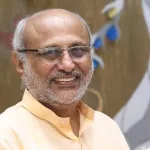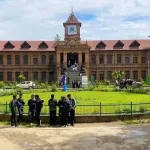Rail has a long-standing position as one of the pillars of passenger mobility and freight transport. It is among the most energy-efficient and cost effective modes of transport as is reflected from the fact that railways carry 8% of the world’s motorised passenger movements and 7% of freight transport, but account for only 2% of energy use in the transport sector. The first rail on Indian subcontinent ran over a stretch of 34 km from Bombay to Thane in 1853. After 75 years of its independence from British colonial rule, India is proud to have the fourth-largest rail network in the world spread over 68000 km route length, after USA, China and Russia carrying 3-4 million tons of freight and 23 million travellers on daily basis from 7,349 stations (IRIR).
Can we imagine India without its railways? Absolutely not. Indian Railways (IR) has attained the status of lifeline of the country and is considered as thebackbone of India’s economy. From the bustling cities to the serene countryside, railways cover every nook and cranny of the country, uniting millions of people and places. A statutory body under the control of the Ministry of Railways, Government of India, IR is the largest public sector undertaking in India running around 11000 trains every day, of which 7000 are passenger, which include among a long list, Rajdhani, Duronto, Shatabdi, Humsafar, and Vande Bharat Express trains.
We have not stopped here. The metro network, which is deemed as the future of fast, safe, affordable and reliable travel, has crossed over 1000 kilometres, across 11 states and 23 cities. It is a significant achievement in the railway history of India with millions of people relying on it for its attractive features. Currently, India ranks third globally in operational metro network length after China and United States. Besides, work on first bullet train from Ahmadabad to Mumbai is expected to get completed by 2026.
For years, Indian Railways imported technology to build its trains. To serve the needs of one of the most populous nations, we churned out more coaches than any country, but still struggled to build trains at par with the best. Our trains lacked the aesthetics and design to compete with the west. It took us more than 70 years after the British left to launch our very own, indigenous semi-high speed train – the Vande Bharat Express – in 2018.
The Vande Bharat trains transformed the nature of rail travel in India, becoming the symbol of an aspirational and resurgent India. It proved that we have the talent and capability to plan, design and manufacture a world-class train set independently. We have developed command on the technology boosting the government to plan export of Vande Bharat trains by 2025-26, a big leap in the direction of Atmanirbhar Bharat.
Under ‘Make in India’ and ‘Skill India’ initiatives, the high speed, heavy freight train engines, WAG-12B locomotives that are being built at one of the India’s largest integrated greenfield manufacturing facilities at Madhepura, Bihar is a fitting example. As a joint venture between Alstom SA of France and Indian Railways, this is the largest Foreign Direct Investment project in the Indian Railway sector that has progressively achieved near 90% indigenization.
Today, the WAG-12B locomotives are not merely ‘Made in India’ for India but are exported too. This technical collaboration and venture has not only put India on the manufacturing and skilled workforce world map but has the potential to boost India’s ambitions of becoming a manufacturing hub. Now India is one of the only six countries in the world to manufacture these high horsepower locomotives. As a part of Atmanirbhar Bharat, 2000 km of our rail network have been equipped with the indigenous world-class technology ‘Kavach’, an anti-collision device (ACD) network, for achieving the goal of “zero accidents”.
Today India builds 4-km rail track per day. In 2024 alone, India built a 5300 km rail network, which is equal to Switzerland’s entire train network. In the past 10 years, India added 31000 km track to its railway network, which is equal to Germany’s entire network and 44000 km of railway networks were electrified (Railway Minister).
‘Viksit Bharat@2047’ is the vision of GOI, an initiative aimed at realizing India’s aspiration of becoming a developed nation by 2047, the 100th year of its independence. However, this initiative seeks to mobilize efforts across economic, social, environmental, and governance domains to achieve comprehensive and sustainable development. History gives every country a period when it advances its development journey manifold. This is the period (Amritkaal) in India’s history, when the country is going to take a quantum leap. Expanding its rail network with 100% electrification and using collaborative research methodologies to make railways safer, comfortable, elegant and swift are a few efforts in this direction.
Today, conventional rail provides nearly one-sixth of the world’s long-distance passenger travel around and between cities. We’re now in an era of high-speed trains which provide a high quality substitute to short-distance intra-continental flights. In cities, metros and light rail offer reliable, affordable and fast alternatives to road travel, reducing congestion and carbon dioxide emissions and local pollution. Freight rail enables high capacity goods movements over very long distances, allowing access to trade for resources that otherwise are likely to be stranded.
Frequent traffic jams on highways and major roads and blockage due to snow/ landslides in mountainous regions is highly annoying for commuters. Ambulances and fire fighters fail to reach their destinations on time leading to loss of lives. Students appearing in various university and competitive examinations often reach their designated centres late or even miss the papers due to traffic jams or other transport related problems, which trains especially high speed ones, are usually immune to.
I remember a horrible and haunting incident of March 1996 when hundreds of Srinagar bound vehicles, including our bus, got stranded at Ramban due to heavy land sliding at Panthyal-Digdol stretch of National Highway. Despite travelling on foot for more than 20 km amid incessant rain, reaching Banihal late in the night, I couldn’t make it to cross the Jawahar Tunnel even next day morning due to overnight snow fall, as a result missed my Combined Services Prelims at Srinagar.
Udhampur-Srinagar-Baramulla Railway Link (USBRL), a challenging project for the engineers and workers with a route length of 272 km comprising 38 tunnels with a combined length of 119 km and 927 bridges with a total length of 13 km shall change the economic and employment landscape of the valley. The 1315 meter long iconic Chenab Bridge which is 359m above the river bed and India’s highest rail bridge, 473 meter cable-stayed AnjiKhad Bridge, 11.2 km long Banihal-Qazigund tunnel in Pir Panjal range, and T-50 tunnel in Khari-Sumber section spanning a distance of 12.77 km, the longest railway tunnel in India, are the engineering marvels of this project. Major part of this project, Baramulla – Sangaldan and Udhampur – Katra,is already operational and recently CRS of its last 63 km segment (Katra – Sangaldan) has been successfully completed.
With the commissioning of USBRL project, an engineering masterpiece ready to give rail connectivity to Kashmir with the rest of India, which is expected very soon, Kashmir’s economy is sure to transform by facilitating faster, affordable, and more reliable transportation of passengers and goods. Passengers intending to visit any part of India can now plan their journeys instantly, unlike past, without making advance and marathon preparations.
Signature Kashmiri products such as apples, cherries, dry fruits, pashmina shawls, and handicrafts will reach markets across India more efficiently, speedily and at lower costs, while the cost of transporting daily essentials including edibles, readymade garments, fertilizer, coal, cement, steel and other construction items to the valley is anticipated to decrease considerably. Besides all this, the establishment of rail network shall generate tremendous employment opportunities for skilled youth especially various types of technicians, and to unskilled ones as security staff and many more.
With rail, a large number of youth get involved with transport industry running cabs and auto rickshaws and many find their jobs establishing small shops and tea stalls or act as vendors around and inside railway stations. Railway stations not only generate employment for skilled and unskilled workforce, but have proved to be potent revenue generating centres for the railway organisation itself. New Delhi Railway Station has emerged as the highest earner in 2023-24 fiscal year having earned an impressive Rs 3,337 crore through various revenue sources like shops, platform tickets, clock rooms, waiting halls and advertisements followed by Howrah station with an income of Rs 1692 crore according to Railway data.
Alas! The festive mood in Kashmir ahead of the historic inauguration of the rail link has turned gloomy amid reports that passengers from Srinagar will have to alight at Katra junction and board a new train for New Delhi, and goods trains are reportedly unlikely to run on this new track. Kashmir Valley Fruit Growers Cum Dealers Union has termed the limited connectivity plan of the Indian Railways as a joke for the horticulture sector (The Wire 11/1/2025). The top leadership of India must revisit any such decision in the large interest of people in general and traders in particular.
District Kupwara, one of the aspirational and frontier districts of J&K, with a population of more than 12 lakhs, is not connected to USBRL like many other places of the UT. The nearest railway station is Sopore which is 40 km away from Kupwara town. People living in Karnah, Keran, Machil and other areas of Kupwara along the LOC cannot get optimally benefitted by this project unless the track is extended, at least up to Kupwara town, for which Final Location Survey (FLS) has been done almost a year ago.
The rail link to Kupwara will boost not only horticulture, tourism, handicrafts and education sector but will bring magical changes to our traders and MSMEs. Our political leadership, including Members of Parliament seem to be insensitive towards such dream projects which have a potential to change the economic and employment landscape of the area to a larger extent. During the current budget session of the parliament I sent a detailed WhatsApp message to one of the MPs of J&K requesting him to raise the question of Sopore–Kupwara railway track but the Hon’ble MP ignoring my request, which was not personal at all, didn’t even show courtesy to acknowledge the message, a clear depiction of hubris syndrome – a common behavioural abnormality associated with power.
The creation of new Rail Division at Jammu, recently inaugurated by Hon’ble Prime Minister and the plans to extend railway connectivity to Uri, Kupwara, Poonch, Rajouri and Akhnoor (Tribune 7/1/2025) has sparked a ray of hope among the people of these far-off places to be stitched into inclusive development through employment generation, infrastructure development and boosting of tourism and trade. With no aversion to induction of bullet trains in select cities, the people living in border areas under challenging circumstances at least deserve basic and economic transport facilities. Having strategic importance, railway link to Kupwara will greatly reduce the transportation costs of troops and defence stores while giving some comfort to civilian population as well. We wonder how the earlier DPR for the first railway track; restricted to Baramulla town was approved, neglecting the north-west extremity (Kupwara) of the valley, despite its high topographic feasibility.
(The Author is Principal (Rtd.) J&K Higher Education Department. Email: [email protected])








